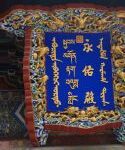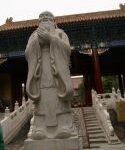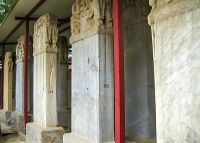Time flies–especially when you are flying West (to go East). If you fly far enough, you lose a day! That’s what happened to us. We left at 1:00 a.m. on Tuesday, and the next thing I knew (after about 18 hours in the air and 4 hours in Seoul) we were in Beijing–and it was 9 a.m. on Wednesday. At least that’s what they told us (sorry, I’m typing much faster than the machine can handle–at 1 yuan a minute I need to).
 Beijing is getting ready for the Olympics, and perhaps the best example I can give you of the face lifting (and of the changes from when I first came in 1990) is the airport. When I came in 90, I still remember the two lane road. You can still see it from the 8 lane expressway! We got stuck behind a horse cart. And the terminal was probably vintage 1940. It was so old they said it was when I was your age.
Beijing is getting ready for the Olympics, and perhaps the best example I can give you of the face lifting (and of the changes from when I first came in 1990) is the airport. When I came in 90, I still remember the two lane road. You can still see it from the 8 lane expressway! We got stuck behind a horse cart. And the terminal was probably vintage 1940. It was so old they said it was when I was your age.
Today, they’ve opened a new terminal that is 3 miles long! And of course, the newest in the world. That seems appropriate given that Beijing is still constructing high rise after high rise, so that when the 3 million people descend on this city for the Olympics (and get stuck in the traffic that even without them is swelled by the addition of one thousand new cars each day!), and they’re stuck in traffic, like we are, they’ll be impressed by the newness of China. I think I read in Business Week that Chinese architects, buoyed by their design work for the Olympic facilities (which we’ll see later this weekend) are aiming for contracts and building around the world. It’s part of the the edifice complex that’s hit all the Asian countries, all of whom want to be able to say “highest, tallest, biggest, or newest” and all can!

 We got in at 9 and have been on the run (or stuck in traffic) ever since. Wednesday was devoted to three of my favorite temples–the Temple of Heaven, the (Tibetan) Lama Temple, and the Confucian Temple, all in central Beijing (about an hour from where we’re staying; I never had a sense of how Beijing sprawls until this trip. We’re far out, and yet hemmed in!).
We got in at 9 and have been on the run (or stuck in traffic) ever since. Wednesday was devoted to three of my favorite temples–the Temple of Heaven, the (Tibetan) Lama Temple, and the Confucian Temple, all in central Beijing (about an hour from where we’re staying; I never had a sense of how Beijing sprawls until this trip. We’re far out, and yet hemmed in!).
The Temple of Heaven is where the emperor regulated the harvest; if he failed, he might lose the mandate of heaven, or the right to rule, and in an agricultural economy (remind me to say something about food prices today, even here) good harvests are important–and the last time I was here, the main harvest hall was being renovated. So, it was exciting to be back and see it without nets and bamboo and falling paint, in splendor that the emperors saw. If only we could have sacrificed a bullock. And there were probably almost as many people in the mile long facility and park as there were in all of the Qing Dynasty period.
The Lama Temple gets
fewer visitors, and like many of the historic places in Beijing, has a great deal of serenity; you’d never know you were in a city of 15 million people and 80 million cars. The temple, like many of the existing historic buildings, owes a lot to the Qian lung emperor, who ruled China in the late 17th century, and was the longest lived monarch in Chinese imperial history. He had many wives and even more girlfriends, many of whom were minorities. And as a Manchu (non Chinese), he had a tendency to support the various forms of Buddhism besides the main one. Tibetan Buddhism was one of his favorites, so he gave a former palace to the Tibetans whom he summoned to Beijing (partly as hostages, I think, to keep the peace)–and today it’s an active Tibetan monastery, which the combination of animism and Buddhism that makes the Tibetan Buddhist statues so frightening and wondrous.
The next door Confucian temple is one of my favorites, because it memorializes scholars who passed the Confucian exams and became the ruling class of China–for centuries until 1908, students vied for good government jobs by memorizing the Chinese classics. The best in each province got to Beijing, and the best of the best wound up getting their Jin Shi degrees and jobs that would earn them money and power. And their names on stone steles.
memorializes scholars who passed the Confucian exams and became the ruling class of China–for centuries until 1908, students vied for good government jobs by memorizing the Chinese classics. The best in each province got to Beijing, and the best of the best wound up getting their Jin Shi degrees and jobs that would earn them money and power. And their names on stone steles.
If you do well, maybe your names will be up here.
Today, the exams (not the topics) are similar, and people get to go to the Beijing University for a route to wealth and power. We like to think of Beida (as it’s abbreviated) as the IWU of China.
We’re off to the Great Wall today, and I better run or I’ll have to miss the bus and run to the wall–and that’s about 50 miles!
Will be back online again, but I hope you all have a wonderful Mother’s Day!
Good-day to me, good night to you!